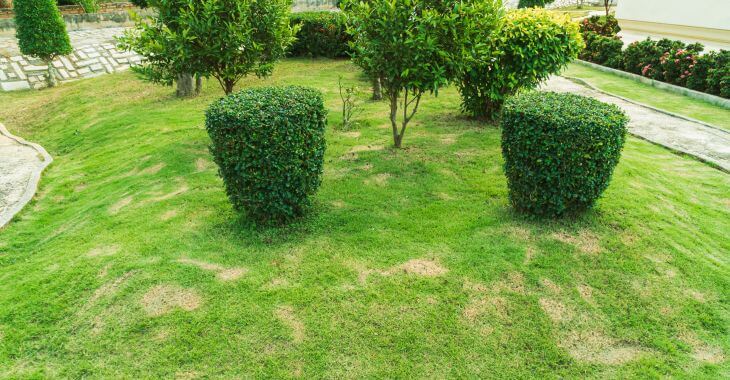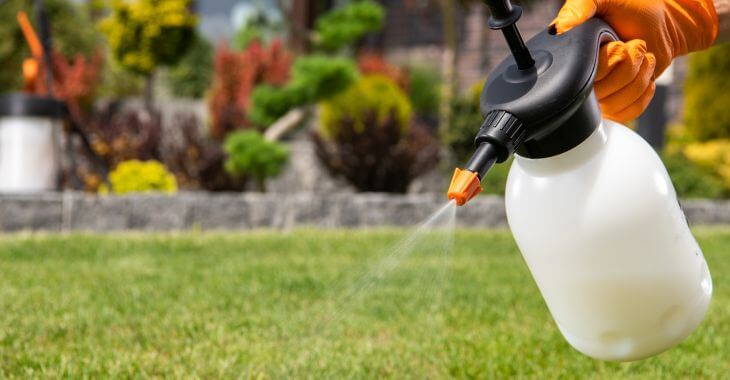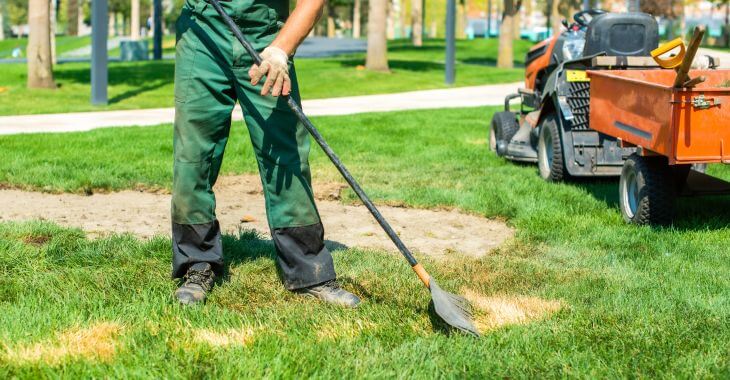How to Identify and Treat Lawn Fungus

A lush, green lawn is the pride of many homeowners, but it’s susceptible to various issues, including lawn fungus. Lawn fungus can quickly turn your green oasis into a brown and unhealthy landscape if left untreated. Here are the types of lawn fungus, how to identify them, and effective treatment strategies.
Common Types of Lawn Fungus
Identifying and treating lawn fungus is essential to maintain a beautiful and thriving lawn. There are a few different types of grass fungus that can impact the health of your lawn. What does lawn fungus look like? Here’s how to identify different types of lawn fungus.
- Brown Patch Fungus (Rhizoctonia spp.): Brown patch is one of the most prevalent lawn fungi and typically appears in warm, humid weather. It causes circular, brownish patches that can range from a few inches to several feet in diameter. The affected grass blades may have irregular tan or light brown lesions.
- Dollar Spot Fungus (Sclerotinia homoeocarpa): Dollar spot appears as small, silver dollar-sized patches with straw-colored centers. It thrives in hot, humid conditions and is most active in summer.
- Powdery Mildew (Erysiphe spp. and others): Powdery mildew forms a white, powdery substance on the grass blades. It’s more common in shaded areas with high humidity.
- Fairy Ring Fungus (Various species): Fairy ring appears as rings of dark green, fast-growing grass surrounded by a band of brown or dead grass. Mushrooms may also emerge in the affected areas.
- Red Thread Fungus (Laetisaria fuciformis): Red thread creates irregularly shaped patches with reddish threads or strands that extend from the grass blades. It’s often seen in cool, wet conditions.
- Rust Fungus (Puccinia spp.): Rust fungus causes grass blades to take on a rusty or orange appearance. It’s more common in late summer and early fall.
Identifying the type of fungus is the first step in effective lawn fungus treatment. Consider the shape, texture, color and damage to the grass blades to determine what type of grass fungus is impacting patch shape.
Also, note the prevailing weather conditions when you observe the fungal symptoms. Some fungi, like brown patch and dollar spot, thrive in warm, humid weather, while red thread prefers cooler, wet conditions.
Effective Lawn Fungus Treatment Strategies
Once you have identified the type of lawn fungus affecting your grass, it’s time to implement effective treatment strategies. The following are possible options for removing grass fungus from your lawn.
Fungicide Application
Fungicides can be an effective means of treating lawn fungus. Different fungicides are designed to target specific types of fungi. Consult with a local nursery or garden center for guidance on selecting the appropriate fungicide for your lawn. Follow the application instructions carefully, and be sure to use personal protective equipment as recommended on the product label.
Proper Watering
Overwatering or watering at the wrong times can create favorable conditions for fungal growth. Water your lawn early in the day to allow the grass to dry before evening. Avoid frequent shallow watering, as deep and infrequent watering helps strengthen the grass and minimize fungal growth.
Improve Air Circulation
Fungi thrive in humid and stagnant air conditions. To improve air circulation, trim overhanging branches, thin out dense vegetation, and avoid excessive thatch buildup on your lawn. This will help reduce humidity and create an environment less conducive to fungal growth.
Fertilize Carefully
Excess nitrogen in fertilizers can encourage fungal growth. Use a balanced fertilizer and apply it according to the recommended schedule for your grass type. Avoid over-fertilization, especially in the summer months.
Dethatching and Aerating
Thatch, a layer of dead grass and debris, can provide an ideal environment for fungal development. Dethatch your lawn if the layer is more than half an inch thick. Additionally, aerating your lawn helps improve air circulation and reduce thatch buildup.
Prune and Remove Affected Grass
If you spot lawn fungus, promptly remove the affected grass and dispose of it in a sealed bag. This can help prevent the fungus from spreading further. Sterilize your gardening tools to avoid cross-contamination.
Change Mowing Practices
Raise the height of your mower to avoid cutting the grass too short. Taller grass provides better shade and retains moisture, making it less susceptible to fungal infections.
Monitor and Prevent
Regularly inspect your lawn for signs of fungal growth. Being proactive in your lawn care practices can help prevent future outbreaks. Ensure that your lawn receives adequate sunlight and is properly drained to discourage fungal development.
Consult a Lawn Care Professional
If you are unsure about the type of lawn fungus affecting your grass or if your efforts to treat it have been unsuccessful, consider consulting a professional lawn care service. They can provide expert guidance and may conduct soil tests to determine the specific issues affecting your lawn.

By recognizing the type of fungus and implementing the appropriate treatment strategies, you can effectively manage and prevent further fungal outbreaks, ensuring that your lawn remains a beautiful and inviting outdoor space for your family and guests to enjoy.
